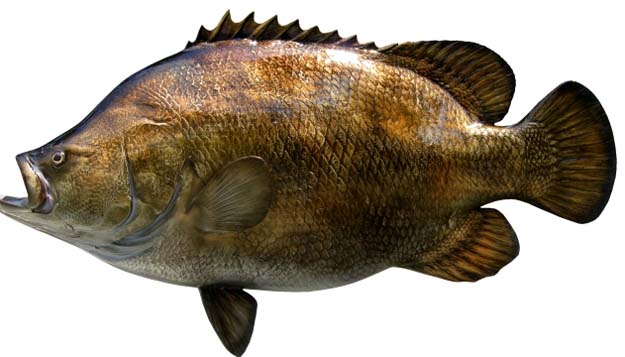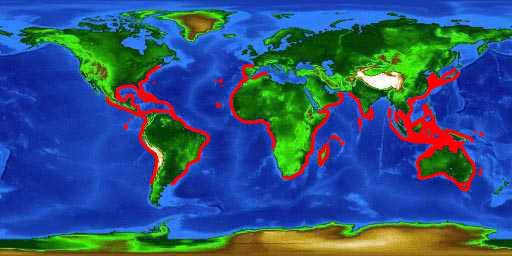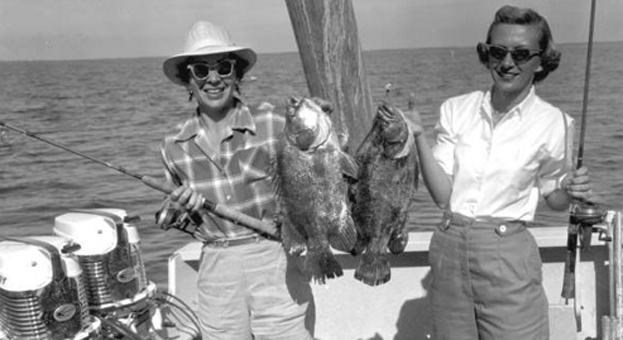Tripletail is a worthy opponent, but only for skilled fly anglers – they’re spooky
[dropcap]F[/dropcap]ly fishing is spoken along the entire Southeastern Atlantic Seaboard and Gulf Coasts. Many fly fishers with a sea thirst can even think in tripletail – an under targeted game fish with great dinner plate creds.
As you can see from the image, they’re a flat, almond-shaped fish with large, round dorsal and anal fins that match the caudal (tail) fin thus, “tripletail.” It’s triangular head becomes even more concave as the fish ages.
Tripletail are a coastal tropical fish with adults preferring a solitary life, choosing to float near shipwrecks, sea buoys, and pilings of jetties, or in the open water hugging anything floating as established cover for ambushing. Smaller fish, juveniles of several heritages, will use Sargassum or any floating debris as a haven, but it’s the lair of a tripletail.
During mating season in the spring and then again in the fall, tripletail become intoxicated and act accordingly. They will attack anything and leap for what seems like no reason – quite something to witness. They will form schools around spawning times along the Atlantic and Gulf coasts. Witnessing spawning behavior, aside from schooling, is unmistakable.
During their presence, adults can also be found in bays, sounds, and estuaries all summer. Juveniles under Sargassum and tidal debris.

Yup, that’s where you’ll find them. Image by Fishing The Everglades.com.
Tools for the tripletail
This creature is fascinating and a legitimate tussle on an 8-weight fly rod for sight fishing. Pick a tropical floating line you like, a reel with a good drag system, but although initial bursts are significant, you won’t need more than 150-yards of 20-pound test backing.
If the fish are all in the 15- or more pounds range you’d be better served with a 9-weight, especially if it’s windy and you’re pitching heavy flies. And yes, they’re acrobatic and can perform multiple jumps while engaged. Their runs, although short lived, are powerful. The maximum weight is about 40-pounds and about 3-feet long, but around 15- to 20-pounds (or less) more common where populations are common.
In the spring, Atlantic Southeast Coast tripletail concentrate just offshore at hot-spots; Port Canaveral, Florida (March–June, 20-to-30-pounders not unusual) and Jekyll Island, Georgia (April–July), and off Beaufort, South Carolina during the same period.

Triple tail by King Sailfish Mounts.com
May is prime throughout its southern realm
The entire Gulf has tripletail all spring and summer. Although they have been caught in some years as far north as Massachusetts, they’re rarely found north of Chesapeake Bay. They’re migratory and considered pelagic.
Concentrating all your approaches to near shore markers will be rewarding. You can successfully blind cast at a marker if you don’t see one. Many of these animals stage their attacks from just a few feet under the surface – off to one side of a buoy of floating board. However, a bunch of blind casts is always a waste of time – two or three and move on. Let your fly sit for a moment – it’s then that they’ll strike.
Use a shock tippet of at least 40-pound mono or fluorocarbon because of the razor sharp gill plates. If you’re IGFA rigged don’t go under 15-pound class tippet.
Flies used are streamers – green and white glass minnows, crabs and shrimp imitations with some brown grizzly feathers on the latter. And, as usual, bright flies on sunny days and dark flies on a darker overcast day. Up to 1/0.

World distribution map for the tripletail (Lobotes surinamensis). Source: Florida Museum of Natural History Ichthyology Department.
Back to approaching the animal – think stealth
You have to be a good caster – able to hit at least 65-feet or better, accurately. The fly should be made to drift into the fish’s window of opportunity so cast considerably away from the targeted prey. When you get an eat, set the hook like tournament bass anglers do – seriously. Oddly, sometimes you can hit the thing on the head and get an eat also.
They do have a frustrating tendency to follow a fly all the way to the boat but never eat. If this happens, let the fly sit when it follows and if it doesn’t eat right away, pick the fly up.
When handling be wary of their gill plate covers, they’re razor sharp.
NOTE: Taxonomy provided by the International Game Fish Association, Florida Museum Of Natural History Ichthyology Department.
Key West Baked Tripletail (Recipe origin unknown)
1/2 cup softened butter, plus more for baking dish
4 (8 ounces) fillets tripletail
One teaspoon salt
One tablespoon lemon pepper, or to taste
Two teaspoons garlic powder
Two teaspoons onion powder
1/4 cup key lime juice
1/4 cup fresh orange juice
12 slices lime
Eight orange slices
Preheat oven to 325 degrees F (165 degrees C). Lightly butter a 9 X 13-inch glass baking dish and set aside. Season the fillets with salt, lemon pepper, garlic powder, and onion powder; place into a prepared baking dish. Spread about two tablespoons of softened butter over the top of each fillet. Pour in the lime and orange juices, then cover each fillet with three slices of lime, and two slices of orange. Bake in preheated oven until fish is opaque and flakes easily with a fork, about 20-25 minutes.
Preheat oven to 325 degrees F (165 degrees C). Lightly butter a 9 X 13-inch glass baking dish and set aside. Season the fillets with salt, lemon pepper, garlic powder, and onion powder; place into a prepared baking dish. Spread about two tablespoons of softened butter over the top of each fillet. Pour in the lime and orange juices, then cover each fillet with three slices of lime, and two slices of orange. Bake in preheated oven until fish is opaque and flakes easily with a fork, about 20-25 minutes.


